Keratinocyte Growth Factor Stimulates Macrophage Inflammatory Protein 3α and Keratinocyte-derived Chemokine Secretion by Mouse Uterine Epithelial Cells
- PMID: 20455876
- PMCID: PMC3837354
- DOI: 10.1111/j.1600-0897.2010.00850.x
Keratinocyte Growth Factor Stimulates Macrophage Inflammatory Protein 3α and Keratinocyte-derived Chemokine Secretion by Mouse Uterine Epithelial Cells
Abstract
Problem: communication between uterine epithelial cells and the underlying stromal fibroblasts is critical for proper endometrial function. Stromal fibroblast-derived growth factors have been shown to regulate epithelial immune functions. The purpose of this study was to determine whether keratinocyte growth factor (KGF) regulates uterine epithelial cell chemokine and antimicrobial secretion.
Method of study: uterine epithelial cells were isolated from Balb/c mice and cultured in either 96-well plates or transwell inserts. Epithelial cells were treated with KGF, epidermal growth factor (EGF), or hepatocyte growth factor (HGF). Macrophage inflammatory protein 3α (MIP3α) and keratinocyte-derived chemokine (KC) levels were measured by ELISA.
Results: keratinocyte growth factor stimulated the secretion of MIP3α and KC. The effects on MIP3α by KGF were specific because EGF and HGF had no effect. In contrast, KGF, EGF, and HGF had similar effects on KC. Furthermore, KGF administered to the apical side of epithelial cells had no effect on MIP3α or KC secretion, indicating that the KGF receptor is located on the basolateral surface of uterine epithelial cells.
Conclusion: we demonstrate that KGF plays a role in uterine epithelial cell secretion of MIP3α and KC, key immune mediators involved in the protection of mucosal surfaces in the female reproductive tract.
Figures
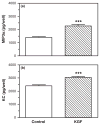
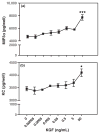
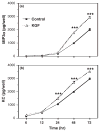
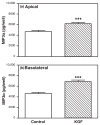
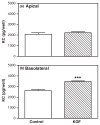
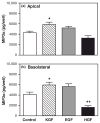

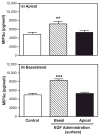
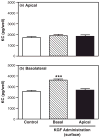
Similar articles
-
Estradiol regulation of constitutive and keratinocyte growth factor-induced CCL20 and CXCL1 secretion by mouse uterine epithelial cells.Am J Reprod Immunol. 2014 Jul;72(1):34-44. doi: 10.1111/aji.12260. Epub 2014 May 8. Am J Reprod Immunol. 2014. PMID: 24807244 Free PMC article.
-
Modulation of chemokine expression on intestinal epithelial cells by Kampo (traditional Japanese herbal) medicine, Hochuekkito, and its active ingredients.J Nat Med. 2013 Jul;67(3):626-35. doi: 10.1007/s11418-012-0724-1. Epub 2012 Dec 1. J Nat Med. 2013. PMID: 23203627
-
Effects of estradiol on lipopolysaccharide and Pam3Cys stimulation of CCL20/macrophage inflammatory protein 3 alpha and tumor necrosis factor alpha production by uterine epithelial cells in culture.Infect Immun. 2005 Jul;73(7):4231-7. doi: 10.1128/IAI.73.7.4231-4237.2005. Infect Immun. 2005. PMID: 15972514 Free PMC article.
-
Hepatocyte growth factor, keratinocyte growth factor, their receptors, fibroblast growth factor receptor-2, and the cells of the cornea.Invest Ophthalmol Vis Sci. 1993 Jul;34(8):2544-61. Invest Ophthalmol Vis Sci. 1993. PMID: 8392040
-
Up-regulation of intestinal epithelial cell derived IL-7 expression by keratinocyte growth factor through STAT1/IRF-1, IRF-2 pathway.PLoS One. 2013;8(3):e58647. doi: 10.1371/journal.pone.0058647. Epub 2013 Mar 12. PLoS One. 2013. Retraction in: PLoS One. 2024 Jun 18;19(6):e0305938. doi: 10.1371/journal.pone.0305938. PMID: 23554911 Free PMC article. Retracted.
Cited by
-
New approaches to making the microenvironment of the female reproductive tract hostile to HIV.Am J Reprod Immunol. 2011 Mar;65(3):334-43. doi: 10.1111/j.1600-0897.2010.00949.x. Epub 2011 Jan 12. Am J Reprod Immunol. 2011. PMID: 21223421 Free PMC article. Review.
-
Innate and adaptive immunity at mucosal surfaces of the female reproductive tract: stratification and integration of immune protection against the transmission of sexually transmitted infections.J Reprod Immunol. 2011 Mar;88(2):185-94. doi: 10.1016/j.jri.2011.01.005. Epub 2011 Feb 26. J Reprod Immunol. 2011. PMID: 21353708 Free PMC article. Review.
-
Role of the innate immunity in female reproductive tract.Adv Biomed Res. 2014 Jan 9;3:1. doi: 10.4103/2277-9175.124626. eCollection 2014. Adv Biomed Res. 2014. PMID: 24592358 Free PMC article. Review.
-
Estradiol regulation of constitutive and keratinocyte growth factor-induced CCL20 and CXCL1 secretion by mouse uterine epithelial cells.Am J Reprod Immunol. 2014 Jul;72(1):34-44. doi: 10.1111/aji.12260. Epub 2014 May 8. Am J Reprod Immunol. 2014. PMID: 24807244 Free PMC article.
-
Estrogen receptor α antagonists mediate changes in CCL20 and CXCL1 secretions in the murine female reproductive tract.Am J Reprod Immunol. 2013 Feb;69(2):159-67. doi: 10.1111/aji.12021. Epub 2012 Oct 1. Am J Reprod Immunol. 2013. PMID: 23025258 Free PMC article.
References
-
- Janeway CA, Travers P, Walport M, Schlomchik MJ. Immunobiology: The Immune System in Health and Disease. 6. New York: Garland Science; 2005.
-
- Vaerman J-P. The secretory immune system. Antibiot Chemother. 1987;39:41–50. - PubMed
-
- Wira CR, Grant-Tschudy KS, Crane-Godreau MA. Epithelial cells in the female reproductive tract: a central role as sentinels of immune protection. Am J Reprod Immunol. 2005;53:65–76. - PubMed
-
- Wira CR, Fahey JV, Sentman CL, Pioli PA, Shen L. Innate and adaptive immunity in female genital tract: cellular responses and interactions. Immunol Rev. 2005;206:306–335. - PubMed
-
- Dockery P. The fine structure of the mature human endometrium. In: Glasser SR, Aplin JD, Giudice LC, Tabibzadeh S, editors. The Endometrium. New York: Taylor & Francis; 2002. pp. 21–38.
Publication types
MeSH terms
Substances
Grants and funding
LinkOut - more resources
Full Text Sources
Research Materials

